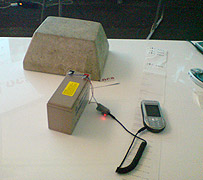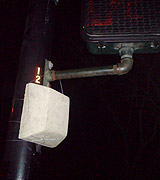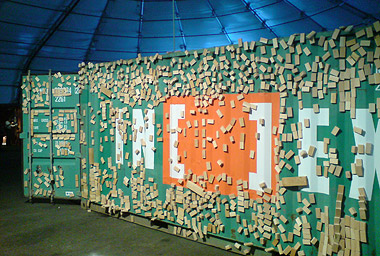

Finland- and UK-based artist-researchers Loca were running their project in downtown San Jose. They had molded hollow concrete objects which they attached to various lamps, traffic lights and signposts. Being made of gray concrete makes them effectively invisible which is important because they contain sneaky cargo: inside, there’s a mobile phone and a power source which lasts around a week. Using a custom software, the phone will continuously scan for devices that have bluetooth enabled and set to discoverable. Every occasion of a tracked device will be sent to the central database and archived there. At their booth they would print out a receipt-style list of the places you’ve been to which in my case was approximately 2 meters long, others were gigantic. Now here comes the fun part: Loca not only collects your data but also tries to combine it with the context of the “urban semantics” it is operating in and tries to draw conclusions from that. Having checked out a few shops and the park for instance, you would suddenly get the message: “You were in a flower shop and spent 30 minutes in the park; are you in love?�?.
Another thing that Loca do is the tagging of photos according to the electromagnetic context of the device at the time they were taken, i.e. the identities of the nearby bluetooth devices. The pictures they have been uploading to Flickr for some time now contain information about the presence of other’s cameras, which already represents quite a history of social encounters, opening a wide field of possibilities for mining and combining the data. There was another work called BlueStates which apparently works in the same direction.
 IN[ ]EX is a project by a Canadian art group which acts as a nice low-tech approach to the spread of digital information. Their piece consist of a shipping container with (initially) 3000 wooden blocks of various sizes attached to it with tiny magnets. There are also a few bigger ones that actually contain sensors for the smaller blocks. The setup has two functions: a sound installation inside the container which is being generated and influenced through the way that the small blocks are attached to the wall of the container and around the bigger, sensitive blocks. The other part is actually participatory since the artists ask visitors to pick a block and take it with them. Ideally, they should attach it to another metal surface in the city, spreading the installation all over the place. IN[ ]EX is meant to “explore the migration of capital, goods, and people through the ports and public spaces of Vancouver and San Jose”, and the Canadian wood did migrate quite a lot. By the time this photo was taken, almost 1000 pieces were already gone and you would see them in the most absurd places, some people get really ambitious with these things.
IN[ ]EX is a project by a Canadian art group which acts as a nice low-tech approach to the spread of digital information. Their piece consist of a shipping container with (initially) 3000 wooden blocks of various sizes attached to it with tiny magnets. There are also a few bigger ones that actually contain sensors for the smaller blocks. The setup has two functions: a sound installation inside the container which is being generated and influenced through the way that the small blocks are attached to the wall of the container and around the bigger, sensitive blocks. The other part is actually participatory since the artists ask visitors to pick a block and take it with them. Ideally, they should attach it to another metal surface in the city, spreading the installation all over the place. IN[ ]EX is meant to “explore the migration of capital, goods, and people through the ports and public spaces of Vancouver and San Jose”, and the Canadian wood did migrate quite a lot. By the time this photo was taken, almost 1000 pieces were already gone and you would see them in the most absurd places, some people get really ambitious with these things.
The exhibition-space at South Hall in San Jose, being a giant temporary tent-like structure, was a bit remindful of the Cargolifter hangar close to Berlin, blimp and blimpsters included!
